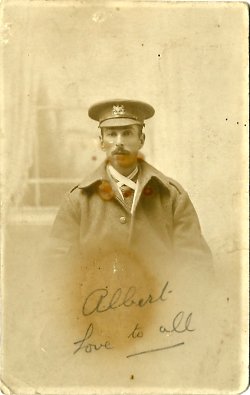 Richard John Hewitt was born in Hanworth in north Norfolk in 1921
Richard John Hewitt was born in Hanworth in north Norfolk in 1921
Dick Hewitt was probably Norfolk's most widely known and well remembered step dancer, a real local character whose dancing, particularly later in life, was brought regularly to a much wider audience than his local community on numerous occasions. He is remembered with fond affection by a great many people, both in his home county and beyond.
 Richard John Hewitt was born in Hanworth in north Norfolk in 1921
Richard John Hewitt was born in Hanworth in north Norfolk in 1921![]() 1 into a large traveller family of musicians and dancers, originally from Ireland, as his daughter Carole Longhorn recalls, “They were Romany gypsies. So that's where the music came from. But granddad played the accordion and nan, she was the dancer. She would step dance. She would go to Cromer and dance on the table. There were four older brothers. The one next to dad, he was a fiddle player, which I never knew until about last year, and there was another one, he was a marvellous singer and then that one there, he kept the Romany tradition up. He lived in a caravan. I never, ever seen him. He left and went his own way. He used to wear, so I was told, shoes and boots with spurs on the back. He kept the Romany tradition up. That's a shame really, cos he was very musical as well. He just sort of parted and went his own way.”
1 into a large traveller family of musicians and dancers, originally from Ireland, as his daughter Carole Longhorn recalls, “They were Romany gypsies. So that's where the music came from. But granddad played the accordion and nan, she was the dancer. She would step dance. She would go to Cromer and dance on the table. There were four older brothers. The one next to dad, he was a fiddle player, which I never knew until about last year, and there was another one, he was a marvellous singer and then that one there, he kept the Romany tradition up. He lived in a caravan. I never, ever seen him. He left and went his own way. He used to wear, so I was told, shoes and boots with spurs on the back. He kept the Romany tradition up. That's a shame really, cos he was very musical as well. He just sort of parted and went his own way.”
The family moved to nearby Southrepps where Dick learned to step dance from his mother, with his father providing the music on melodeon, as he later recalled to Bridget Yates: “Well, that was from my mother and father, you know. My mother used to do the dancing and my father used to play the accordion, but he could step dance as well. It wasn't unusual for a woman to do it… My people came from Southrepps. My uncles and grandfather, they could all do it. They used to do it in the public house, cos years ago they used to have the old accordions and fiddle and get up and dance one another off the floor… I picked it up from my parents. I used to go round with them. I started when I was seven year old with one foot only, then I got the other one to follow, you see… You have to start young; you can't just pick it up. You've got to keep your ankles loose.”![]() 2
2
During the Second World War Dick joined the Royal Norfolks as an army bandsman, playing drums. He was sent to the Far East and was captured by the Japanese, spending several years as a prisoner-of-war in gruelling conditions. His nephew Peter Hewitt comments, “He was on that Japanese Railway of Death, y'know, and felt that the only way he kept alive at that time is he used to keep troops and people happy. And the Japanese liked the way his talent; y'know, he used to dance to them, and he felt assured that was the way of him keepin' alive is entertainin', and they used to love that, y'know; he used to say that: “That's how I got home.” And when he came across from the boats…he used to dance; he danced comin' back and entertained 'em on the ship.”![]() 3
3
Carole Longhorn also remembers being told about this ability to entertain others in times of severe hardship: “I think he was a drummer in the army, before they got shipped to (the Far East). On the way back, when they were released from (being) prisoners of war, he was kept out there to recuperate, and when they came back I think they done a show on the boat coming back home. He danced and sang; well, to the best of his ability.”(here referring to his physical condition). 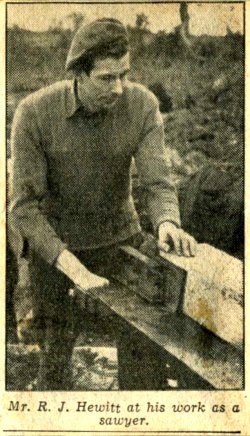 His health never fully recovered from these wartime experiences, with a tumour appearing behind one eye and regular visits to a specialist tropical disease hospital in Ely for years afterwards to treat malaria and parasites in his feet.
His health never fully recovered from these wartime experiences, with a tumour appearing behind one eye and regular visits to a specialist tropical disease hospital in Ely for years afterwards to treat malaria and parasites in his feet.
Back from the war, Dick settled back in Southrepps, living at 3 Chapel Street and raising a family. He married Marion in June 1946 and had two children, Carole in 1947 and Brian in 1949. During this time he worked as a sawyer for Eastern Counties Timber Company. In 1954 Seamus Ennis visited the village and surrounding area, recording traditional music and song for the BBC. Basing himself in the village's Vernon Arms public house, he recorded much material and a selection was used in a broadcast of As I Roved Out, which went on air on Sunday 2 January, 1955. Dick was featured step dancing to Harry Baxter playing The Yarmouth Hornpipe on the fiddle.![]() 4
4
This radio broadcast was to bring Dick Hewitt to a wider audience than his home community. It was heard - and recorded - by Russell Wortley, the Cambridge representative of the English Folk Dance and Song Society. This led to an invitation to perform at Cecil Sharp House and the Royal Albert Hall in London. An undated newspaper article (presumably from 1959, by the reference to Dick Hewitt's age) reported the event thus, under the headline 'To Dance for Norfolk in London':
“It is a far cry from sawing wood at the end of a lane at Southrepps to the platform at the Royal Albert Hall to demonstrate traditional Norfolk step dancing, but that is the change that Mr Dick Hewitt of 3, Chapel Street, Southrepps, will make this week.On Friday and Saturday evening Mr Hewitt, aged 38, a sawyer in the employ of the Eastern Counties Timber Company, one of the few remaining traditional Norfolk step dancers, will perform for the benefit of members of the National Folk Dance and Song Society.
According to Mr Hewitt these dances had not been seen in London in recent times until he paid a visit to Cecil Sharpe (sic) House in London in December.
His family whose roots were in Southrepps, he said, were all musicians and Norfolk tap-dancers and it was from his father, who still plays the melodion (sic) for him when he practises at home, that he learned the intricacies of the Norfolk dances - hornpipe, waltz and march.
These dances had their origins, so it is said, from the habits of people when warming their feet on cold days; a sort of dance developed from he foot stamping,” he explained.
Mr Hewitt wears no traditional costume for his dances. He has performed in the Southrepps Vernon Arms public house. Traditionally public houses were the “theatres” the old folk dancers used. It was at the Vernon Arms that a visiting BBC man was introduced to him and made a sound recording of his dances.”
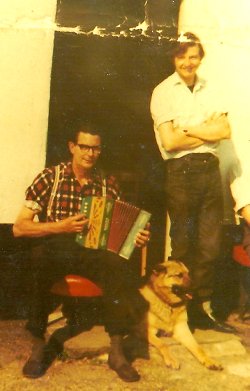 It is difficult to ascertain the accuracy of the reporting, but interesting to note that according to the article Dick learned his dance steps from his father rather than his mother. What is certain though is that Dick Hewitt's step dancing was reaching a wider audience than the village of Southrepps and was being appreciated. About this time Dick had a job as a salesman for cleaning products which took him, amongst other places, around the pubs such as Antingham Barge where Cromer fishermen and others would gather for a bout of step dancing at lunchtime. Here it was perhaps that Dick Hewitt met Percy Brown, the melodeon player who would be his accompanying musician on countless occasions over the next decades, including for recordings, film and television.
It is difficult to ascertain the accuracy of the reporting, but interesting to note that according to the article Dick learned his dance steps from his father rather than his mother. What is certain though is that Dick Hewitt's step dancing was reaching a wider audience than the village of Southrepps and was being appreciated. About this time Dick had a job as a salesman for cleaning products which took him, amongst other places, around the pubs such as Antingham Barge where Cromer fishermen and others would gather for a bout of step dancing at lunchtime. Here it was perhaps that Dick Hewitt met Percy Brown, the melodeon player who would be his accompanying musician on countless occasions over the next decades, including for recordings, film and television.Carole Longhorn recalls these post-war times: “I can remember, I think his dancing kept us poor, because when he first left the army he got a job on the Kleeneze and he'd go round and he'd supposed to be selling his wares, but he'd drop in at the pub and have a dance! And that would be it, so he never, ever made any money. That was a very magical time.” Likewise, Ray Bird, formerly the landlord of Antingham Barge: “You imagine that old floor…I never did know 'em put a wooden board down here. That other room is nine inch tiles, isn't it? He (Dick Hewitt) used to come in here. That was either Kleeneze or Bettaware, we couldn't remember which; he used to come round selling brushes.”
In the early 1960s Dick Hewitt moved to Melton Constable and worked in the bakery, as recalled by village resident Fred Dent: ”This building opposite was a bakery, and I worked in there. And I worked there when I first left school for a while, before I went on the railway. Well, in later years I came back there and worked for a while, and Dick was actually working there at the time. So I worked with Dick in the bakery for a while. That would've been somewhere between '61 and '64. That was the character he was, you see. He was very happy-go-lucky, and he'd often burst into song and tell a few jokes and do a step dance. Soon go to a “board meeting”, as he called it! That was his favourite expression, yes. Used to carry this big board. Didn't sound very good on carpets, you see! Dick was always a good laugh. He played a melodeon as well. Yeah, he'd soon play a tune. And he used to rattle a tune out with his fingers on a crisp tin, I remember.”
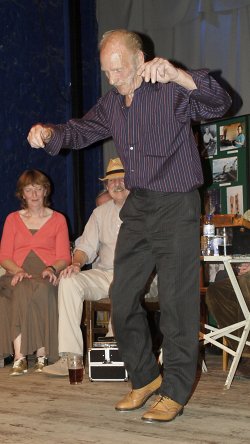 In 1965, Dick became landlord of The Three Horseshoes, on the outskirts of neighbouring Briston. The pub became a lively one for music, song and step dancing, both with the locals on a regular basis and with those visiting the village for Briston Fair, as Carole Longhorn remembers: “But once dad was in the pub, he did keep it going; we had lots of lovely musical evenings. There was the Wests, they came from Briston. At certain times of the year they'd all congregate in Briston and of course they'd use local pubs. Have quite a sing-song and a dance; all get up and dance. I should think almost every night there'd be music and dancing. Lots of step dancing. Especially, like I say, when the fairs were on, when they congregated in the village.”
In 1965, Dick became landlord of The Three Horseshoes, on the outskirts of neighbouring Briston. The pub became a lively one for music, song and step dancing, both with the locals on a regular basis and with those visiting the village for Briston Fair, as Carole Longhorn remembers: “But once dad was in the pub, he did keep it going; we had lots of lovely musical evenings. There was the Wests, they came from Briston. At certain times of the year they'd all congregate in Briston and of course they'd use local pubs. Have quite a sing-song and a dance; all get up and dance. I should think almost every night there'd be music and dancing. Lots of step dancing. Especially, like I say, when the fairs were on, when they congregated in the village.”
The Wests are a large travelling family, several of whom were living in Briston at the time Dick Hewitt was landlord of The Three Horseshoes. In 1956 Peter Kennedy recorded various family members step dancing at Friday Bridge, outside Wisbech, for the BBC: Frank West step dancing and 'tuning' for his son John to dance to, John playing mouth organ for his father to dance to and dancing to a record of Bluebell Polka, and sons Percy, Nelson and Alfie (13, 9 and 9 respectively) dancing, mainly to John's playing. On this occasion Frank West also sang Bold Drunkards and Died For Love.![]() 6 Percy and his wife Doreen, now living in Palgrave, near Diss, perform regularly at a great many events across East Anglia and beyond, Percy winning the local championship in 2006.
6 Percy and his wife Doreen, now living in Palgrave, near Diss, perform regularly at a great many events across East Anglia and beyond, Percy winning the local championship in 2006.
Dick Hewitt was undoubtedly a very fine step dancer, one who danced to a variety of rhythms and tempos other than just the hornpipes asked for by many dancers. In 1972 he described his style, as the 'Norfolk' step dance to Bridget Yates: “The Norfolk step dance is different from the Lancashire clog dance, which is just toe and clapping the sides of the feet and heel, but with the step dance you're using the whole of the bottom of the foot, you see. You do your heel, middle and toe, or your toes, or your toes and your heel. Now you get a triple, double triple and a double double. I never tried to teach anybody… You got two persons, one opposite another until one dropped out and somebody else would get up, sort of a competition. Double shuffle is another name, and triple shuffle; heel and toe, and the toe for the steps. A lot of fishermen used to do it, on board ship I suppose. I don't wear any special clothes; just ordinary shoes with maybe a few tacks to make it sound more. Course, years ago they used to do it in the hobnail boots, on a brick floor. You can hear it, you see!... I dance to the hornpipes, waltzes, marches and also to the polka.”
Dick Hewitt was one of various musicians and step dancers visited by Peter Clifton and Anne-Marie Hulme, as part of over four years research in the mid 1970s into step dancing in north Norfolk. 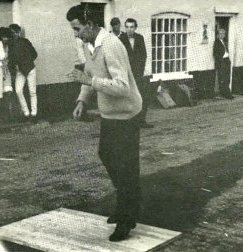 They identified three distinct styles they found: '(i) an intrinsic and deep rooted style of dancing which we call Norfolk Stepping, (ii) the stepping characteristic of the travelling people - as old or possibly older than Norfolk Stepping, which we call Travellers' Stepping, (iii) a degenerate form of what is commonly called modern Lancashire stepping performed by the Davies family of fishermen in Cromer.' They considered Dick Hewitt to be the only person still dancing in the 'Norfolk Stepping' style:
They identified three distinct styles they found: '(i) an intrinsic and deep rooted style of dancing which we call Norfolk Stepping, (ii) the stepping characteristic of the travelling people - as old or possibly older than Norfolk Stepping, which we call Travellers' Stepping, (iii) a degenerate form of what is commonly called modern Lancashire stepping performed by the Davies family of fishermen in Cromer.' They considered Dick Hewitt to be the only person still dancing in the 'Norfolk Stepping' style:
Dick learnt to step from his mother's family at the age of seven in 1928. Stepping in the Neave family can be traced to Dick's great-grandparents. When Dick was young he saw many dancers of a similar style. His dancing can be broken down into three basic movements taught to him by his uncle George: the single, double and treble. In addition to these basic movements he employs shuffles, steps, hops and heel clicks to build up various sequences of movements which he fits together at will. Today he dances three routines: The Hornpipe, The Waltz and The March, the latter being a faster version of The Hornpipe.Dick Hewitt has used his dancing skill to great advantage throughout his life - in concert parties during the war, as an entertainer hired for weddings and other celebrations after the war, using the title of “Dick Hewitt the Norfolk Step Dancer.” His fame as a dancer contributed to his success as a publican during the ten years from 1964 that he ran The Three Horseshoes at Briston. Dancers and musicians were welcome and he kept a collection of musical instruments behind the bar, serving late on a good night. The pub was a favourite of travellers such as the Wests who were known to stay all day playing, singing and dancing.”
7 In 1979, Peter Clifton and Anne-Marie Hulme combined with the late film maker Barry Callaghan to produce a film of Dick Hewitt step dancing in Briston, with Percy Brown providing the music on the melodeon.
8
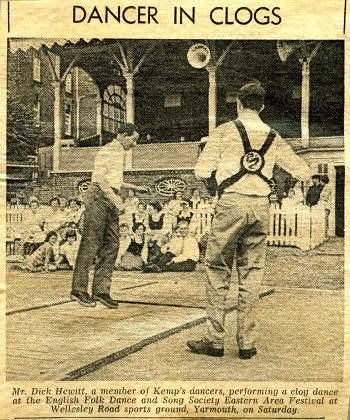 The time that he was landlord of Briston Three Horseshoes, was also a time of increased interest in Dick by the English Folk Dance and Song Society, after the initial enthusiasm of Russell Wortley. Local Morris dance sides, musicians and various interested people from the local folk revival were regular visitors to the pub, where they received a warm welcome. Not all agreed that Dick was fully appreciated in his native county however, as a couple of newspaper letter exchanges from 1966 reveals. Firstly Sid Langley reported that 'Dick Hewitt, of Briston, is a classic case of a prophet not being honoured in his own county. Dick, who lives at Briston, is well known nationally as a clog dancer, (sic) and appears regularly on Midlands television. He is a member of a Birmingham set of dancers and frequently travels to the Midlands to perform. Norfolk, apparently, doesn't want to know.' To this Norris Winstone of Kemp's Men Morris retorted: “I was very surprised to learn that 'Norfolk apparently doesn't want to know' about Dick Hewitt, the Norfolk Step Dancer. As bagman of Kemp's Men, the Norwich Morris team, I have known Dick Hewitt for a number of years. On many occasions he has joined the team on day, afternoon and evening tours. Only four weeks ago Kemp's Men journeyed over to the Horseshoes at Briston, where Dick is the landlord, for an evening of Morris and step-dancing and folk singing.' Whatever the disagreements, Dick certainly seems to have been pleased with his visitors and his involvement with the Society and the folk revival in general, as Norwich country dance teacher and enthusiast Joan Roe wrote in another letter in 1966: 'His is the only pub I know which has the badge of the EFDSS painted over the door.' Dick Hewitt certainly seems to have enjoyed performing with various local revival groups in the county and beyond, and a local newspaper article dated 10 July, 1965, entitled 'Dances of old England at Yarmouth', mentions his step dancing as part of the Kemp's Men group, with a photograph of him dancing in clogs at the event.
The time that he was landlord of Briston Three Horseshoes, was also a time of increased interest in Dick by the English Folk Dance and Song Society, after the initial enthusiasm of Russell Wortley. Local Morris dance sides, musicians and various interested people from the local folk revival were regular visitors to the pub, where they received a warm welcome. Not all agreed that Dick was fully appreciated in his native county however, as a couple of newspaper letter exchanges from 1966 reveals. Firstly Sid Langley reported that 'Dick Hewitt, of Briston, is a classic case of a prophet not being honoured in his own county. Dick, who lives at Briston, is well known nationally as a clog dancer, (sic) and appears regularly on Midlands television. He is a member of a Birmingham set of dancers and frequently travels to the Midlands to perform. Norfolk, apparently, doesn't want to know.' To this Norris Winstone of Kemp's Men Morris retorted: “I was very surprised to learn that 'Norfolk apparently doesn't want to know' about Dick Hewitt, the Norfolk Step Dancer. As bagman of Kemp's Men, the Norwich Morris team, I have known Dick Hewitt for a number of years. On many occasions he has joined the team on day, afternoon and evening tours. Only four weeks ago Kemp's Men journeyed over to the Horseshoes at Briston, where Dick is the landlord, for an evening of Morris and step-dancing and folk singing.' Whatever the disagreements, Dick certainly seems to have been pleased with his visitors and his involvement with the Society and the folk revival in general, as Norwich country dance teacher and enthusiast Joan Roe wrote in another letter in 1966: 'His is the only pub I know which has the badge of the EFDSS painted over the door.' Dick Hewitt certainly seems to have enjoyed performing with various local revival groups in the county and beyond, and a local newspaper article dated 10 July, 1965, entitled 'Dances of old England at Yarmouth', mentions his step dancing as part of the Kemp's Men group, with a photograph of him dancing in clogs at the event.
Upon retirement from being landlord of Briston Horseshoes in 1975, Dick Hewitt lived in Melton Constable again and was night watchman at the Bernard Matthews turkey farm in Briston, as recalled by Celia Ward, then lodger in the neighbouring house: “He didn't really take to Bernard Matthews style of production of meat, and would open the air vents to allow them a bit more fresh air and a little less stench, which used to make them quite cross at Bernard Matthews, but he didn't really believe in following their rules about turkey breeding.”
When retired completely, and no longer out step dancing very regularly, he continued to be very active, as Celia Ward remembers: “He would come every day to work in the kitchen garden that went with the house where I lodged at the time, and kept chickens as well; and looked after the ducks, of which there were a great number. 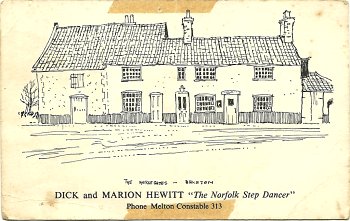 And he would rear the ducklings with great care, so very few would be lost each year, and he would look after them and round them all up, to be taken to the butcher's for slaughtering in the autumn. And when people came to stay, he would always present us with beautiful boxes of vegetables he arranged; he picked from the garden and brought in… He was a very lively old man, a very bright character. Good humoured and full of a kind of joy of living. So, you know, he took great pleasure in the present.”
And he would rear the ducklings with great care, so very few would be lost each year, and he would look after them and round them all up, to be taken to the butcher's for slaughtering in the autumn. And when people came to stay, he would always present us with beautiful boxes of vegetables he arranged; he picked from the garden and brought in… He was a very lively old man, a very bright character. Good humoured and full of a kind of joy of living. So, you know, he took great pleasure in the present.”
Even when too old to be able to step dance, the rhythm still remained with Dick, as recalled by his son-in-law Clive Longhorn: “Well, he used to craze me, towards the end, though. He'd sit in the chair; and he always had hard armchairs; and he'd be sitting watching the telly, and he couldn't move his feet, and he had rings on his fingers, and he'd never keep still. He'd be just rattlin' all the time, doin' the stepping with his fingers, I suppose, all the while.”
Dick Hewitt died in October, 1994. The Eastern Daily Press ran a short obituary on 31.10.94: 'Dancer was also publican… One of Norfolk's leading step dancers, Dick Hewitt, has died, aged 72. He was born at Hanworth, near Cromer, into a musical family - his mother was a dancer and his father used to play the accordion, accompanying his son on several occasions. After serving in the Army, Mr Hewitt had various jobs, including 10 years as publican at The Three Horseshoes at Briston, near Holt, from 1965 to 1975. During his step dancing career he appeared on local television and at the Royal Albert Hall. After retiring in 1984, he spent several happy years at Briston but was taken into Kelling Pine Heath Nursing Home five weeks ago and died there on Friday.' The day after the funeral, Radio Norfolk broadcast a tribute on 04.11.94, coining the very apt description: 'A True Norfolk Man'.
Chris Holderness - 20.5.10
Rig-a-Jig-Jig: A Norfolk Music History Project
2. Transcript of interview, dated 13.04.72.
3. Interviewed by Keith Skipper for Radio Norfolk on 04.11.94, for the tribute broadcast Dick Hewitt: A True Norfolk Man.
4. See article MT221, as above, for full information about this broadcast, plus a sound clip of this recording.
5. See article MT211: Percy Brown: Aylsham Melodeon Player.
6. Sound recordings on Folktrax CD423: Folklife Feasts of Cambridge and the Fens (No longer available). The Wests' style, and that of Frank in particular, was what Peter Clifton and Anne-Marie Hulme considered to be 'travellers' stepping'.
7. From Solo Step Dancing within living memory in North Norfolk, in Traditional Dance - volume 1, 28.03.81.
8. Dick Hewitt: Norfolk Step Dancer, with Percy Brown, melodeon. EFDSS video. (Not currently available.)
Heel and Toe, Veteran VT150CD. Dick Hewitt step dances to a medley of hornpipes from Percy Brown (also included on VTDCD11CD above).
Article MT245
| Top | Home Page | MT Records | Articles | Reviews | News | Editorial | Map |